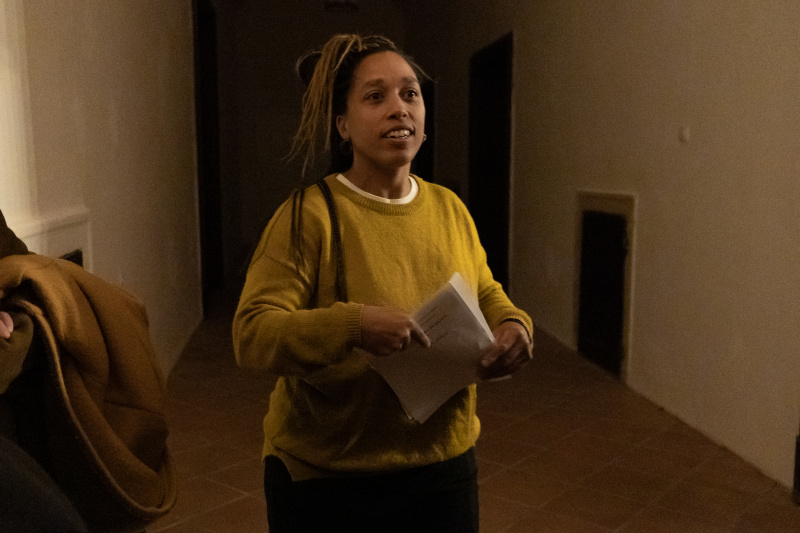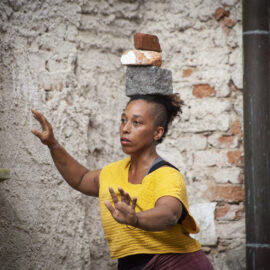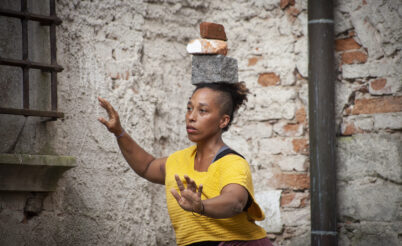
I admire the way how the Swiss artist Stéphanie Nyota N'Duhirahe, originally from the Democratic Republic of Congo, who has been living in the Czech Republic for fourteen years, approaches the impact of political events on a personal history.
SE.S.TA Centre for Choreographic Development hosted circus artists Stéphanie Nyota N’Duhirahe and Morgane Widmer as part of the ART CLUSTERS residency in Žďár nad Sázavou. Both artists come from Switzerland, but has been a solid part of the Prague circus community based in Kulturní dům Mlejn since 2010. Each came to the residency with their own project: Stephanie with her experimental collage ŠRÁMY / DĚTI Z BAKELITU (Children of bakelite), where she processes the experiences of people who had been children during the Velvet Revolution and Morgane with her project CARCASSE, which thematises the social and environmental impact of women’s clothing. In the projects they switched roles, which is a sympathetic ecological practice within their platform Cie Pieds Perchés. Unfortunatelly I didn’t catch up Morgan for the interview, so let’s dive into the interview with Stéphanie.
Do the works ŠRÁMY / DĚTI Z BAKELITU and CARCASSE have any connection?
The only connection that the two works have is that they are both represented by the company Cie Pieds Perchés. Carcasse is a solo project by my artistic partner Morgane, where I am an outside eye. Last year, we worked on my solo piece Šrámy / la débattue, which ended up not even being a solo. We were three of us on stage: performer Nguyễn Mỹ Ngân, musician Roman Džačar, and myself. Morgane, together with Markéta Stránská, were our outside eye for the acrobatic parts.
What prompted you to further develop the project ŠRÁMY?
The Šrámy project is like one tree. In Šrámy/ le debattue, I explored my family history and questioned the visible and invisible traces that certain historical events may have left on a family. I dealt with the questions such as:
What is remembering?
What do we and what do our bodies remember and retain from different life stories?
How is the history of pain transmitted from generation to generation?
How can we talk about this pain?
Šrámy / la débattue was my story and the story of my father, who was 10 years old when the country where he came from – The democratic republic of Congo – has undertaken decolonization. I was interested in how he perceived this reality as a 10 year old boy. How the situation had affected him, and how this event subsequently affected me. I have often talked about this events with friend of mine who is Czech and was born in 1980. So he was almost 10 years old as well as my father, during the events of 17th of November 1989. And since I live in the Czech Republic with my partner who is Czech, I was interested in how the events of the transition from a communist regime to a democratic society after 89′ affected people of my generation and my father’s generation. So the project ŠRÁMY / DĚTI Z BAKELITU is another branch of this tree.
How can our reader imagine the project ŠRÁMY / DĚTI Z BAKELITU?
DĚTI Z BAKELITU is an experimental collage that is created through the composition of different art forms. It combines elements of sound and video installation, which are activated by small movement and acrobatic performances, supported by an authentic musical accompaniment. Thanks to residency in Žďár nad Sázavou, I was able to follow this inquiry through conversations with other people. I was interested in how this pain has or hasn’t been processed. How people remember the regime before and after.
I was intrigued by your comparative study concerning memories of people who were born in between the years 1976-1983, so during Velvet Revolution in 1989 they had around 10 years. How do you work with these testimonies?
I was interested in what children aged 10 to 12 years old remember and retain about this period of change. What attracted me were descriptions of what was before and after upheaval. Conceptually, I have an idea on the direction of development ŠRÁMY / DĚTI Z BAKELITU, but I’m creating it together with Markéta Stránská, who is actually a child of bakelite and also the dramaturge of the project. In the beginning I drew on the experience of my team: Eva Lédlová, who is a bit younger, and Maary/ Nguyễn Mỹ Ngân who was born to Vietnamese parents in the Czech Republic, Roman Džačár a musician with whom I have been working for a long time. I felt that we needed more testimonies, bigger and more colourfull samples of experiences.
Quite by chance, I found a diary of a 10-year-old child, in which the day-to-day circumstances of this period were recorded. I was delighted to have a piece of personal documentary history in my hands, even though some days were recorded only sparingly: “I came home from school, took my bicycle and went to bed in the evening.” Of course, I needed more than that to develop the project, but it was an important piece in my process.
Later we started to work out the interview questions. I didn’t want to ask directly: “What was it like for you in 1989-1990?” I was interested in perception, emotion, imagination, space, sound. Yes, I admit it’s hard even for myself to remember what I did as a 10-year-old kid. We were thinking about how to open up a space in people’s minds to think and return to period around 1989 with questions like:
Do you remember what you liked to eat when you were 10 years old?
Do you remember the space you used to play in?
Did you revisit those places?
Did you notice if they had changed?
And if so, how have they changed.
When I read the description of the project ŠRÁMY / DĚTI Z BAKELITU, I was exactly 10 years old in 1989. So I took some time to reflect on what I was doing then, where and how we lived, how I perceived the time before and after. I remember the enthusiasm and indescribable relief of my parents when the Velvet Revolution happened. However as a child I couldn’t grasp it intellectually. Thanks to my parents‘ joy, these vibes and the expectation of a bright future spread. I also reflected on this age from the perspective of my son, who is 9 years old, and asked myself how he perceives current political events. He has been coming with us to anti-Fico government protests in Slovakia since 5 years ago and he simply is part of talks about politics. Usually I don’t have access to these memories. So you made me a good „trip“, even shed a tear. Thank you.
So I’m sure you remember the tights with the gaiters pulled up over the shoulders and the lap of them hanged down to the knees. LAUGHTER… But is that interesting to you? Because to me, Stéphanie, that level of personal history is absolutely fascinating. By collecting memories of different people, we shared our personal history and for the sake of this project we have got a more layered and colourful picture about history.
I had an opportunity to see ŠRÁMY/la débattue at the Korespondance Festival. It was a really emotional experience for me. At that time I finished reading the book Body keeps the score by Bessel van der Kolk. Do you remember me talking about this book quite enthusiastically while I was accompanying you from the festival? Is the project Šrámy/la débattue buffering with your own personal history?
Yes, it’s been a healing process. First of the important thing for me was to realize that I have this generational trauma. Just talking about it had helped me to come to terms with my history. I had never talked about it before. It also gave me an answers to why I function or think in a certain way. There is always a reason why we behave in a certain way. It was really relieving when I found out that this could have an origin. It does make it a little easier if we knows where our anxiety stems from. And we can perhaps change it. During creative process, I was looking for an intimate way to share my-our-personal and family history. As a performer I have confidence and belief in myself. However by speaking out and performing about it I found myself in vulnerable position. And I think by expanding the show to a trio, we allowed the audience to experience the show on multiple levels. Audiences respond differently to stories depending on what color is your skin, what is your age, your gender, etc.
What reactions have you gotten from your family, friends, or spectators to this work?
My family hasn’t seen the show yet. They should be coming in February. (Redaction note: 2024) It’s going to be quite a challenge to perform the piece in front of my dad: „My father told me that” (excerpt from the performance) …. Laughing… But I’m looking forward to them coming. They’re really part of the process. We worked together in residency in Žďár. I made my father talk about his experiences, I recorded him talking, how he formulates the words, what sounds he makes while he was talking about it. My sister Cécile Nduhirahe was also a part of the project. This drawing is from her and basically all the objects we use in the project come from my sister’s drawings.
If I talk about feedbacks of wider circle of spectators who saw the show, they understood the story and could relate to it in their original way. So that was really nice feedback for me. I didn’t want them to mediate message about decolonization directly: ”Yeah, so somebody’s talking about decolonization.“ It was not my interest.
In the ŠRÁMY / DĚTI Z BAKELITU project, we want to share basically the recent history of the Velvet Revolution, but it’s still too close. We need time to talk about difficult experiences from the past.
Do you think 30 years is a short time?
Yes, it’s too close. Imagine how long it takes us to talk about it – 50 years. And I decided to take this challenge. Without this challenge my father perhaps would not be able to talk about those atrocities at all. We are the second generation of decolonization and we can really see the impact of my dad’s storytelling. Talking about decolonization is painful and one tries to internally hold the pain and somehow deal with it alone.
… SILENCE….
When are ŠRÁMY / DĚTI Z BAKELITU are due to premiere?
ŠRÁMY / DĚTI Z BAKELITU will be premiered in Prague – Vysočany, on 17. and 18. april 2024, in STUDIU PRÁM.
If you would like to take an imaginative journey about project ŠRÁMY / DĚTI Z BAKELITU have a look on the VIDEO IMAGES
More information about Stéphanie Nyota Nduhirahe and Megane Widmer find here WEB
GOOD LUCK!

